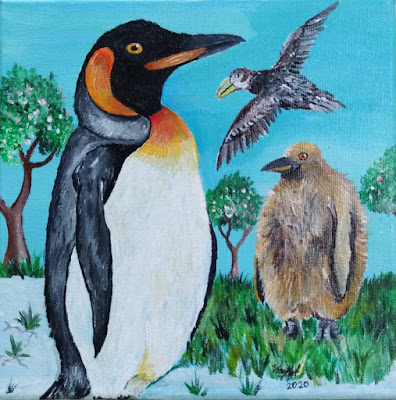Collection: Avian Assortment II
AVIAN ASSORTMENT II
As one of the most colorful classes in the animal kingdom, birds (or aves) come in an assortment of shapes, sizes and colors. The bird class adapts a colorful spectrum of feather varieties, as well as some unique features and lifestyles, to adapt to the ever-changing natural world.
Avian Assortment Vol. 2, acrylic on canvas, 2020. Set of 9, each piece 8" X 8"
Bearded Vulture
Bearded vulture, acrylic on canvas, 2020
Like other vultures, the bearded vulture (Gypaetus barbatus) is a scavenger which feeds on dead animals. However, it is unique among other vultures for its digestive system: the powerful stomach acids in its stomach is able to dissolve bone, which enables the vulture to swallow and digest large bones. This vulture ranged from Europe and Africa to the Middle East, southern and central Asia. In the painting, a golden eagle encounters a pair of bearded vultures.
Japanese Cranes
Cranes in Springtime, acrylic on canvas, 2020
The Japanese or red-crowned crane (Grus japonensis) is regarded as a good luck symbol to East Asian cultures. In Taoism and Chinese culture, the crane is a symbol of longevity and immortality, as it is often associated with immortal deities. In Japan, the crane is believed to live for 1000 years.
Flamingo
Flamingo Dance, acrylic on canvas, 2020
These are several species of flamingo, and two are featured in the painting: the greater and lesser flamingo. The greater flamingo (foreground) had a wide distribution range which spread across Africa, southern Asia, the Middle East and southern Europe; while the lesser flamingo (standing on lake with wings spread) can be found in the African continent and parts of India. Flying overhead is a hoopoe (Upupa epops), is known for its distinctive call and feather crown.
Ostrich
Ostrich Nest, acrylic on canvas, 2020
The largest living bird, ostriches lay the largest eggs in the animal kingdom. Ostrich eggs are usually incubated by females during day time and males during night time. Each egg measures around 15cm long and weigh as much as 1.4 kilograms, over 20 times the weight of a regular chicken egg.
Pelican
Pelican Feeding, acrylic on canvas, 2020
The brown pelican (Pelecanus occidentalis) is a species of pelican which can be found throughout the Americas. The pelican in the foreground is seen holding a large fish in its throat pouch. Another bird in the painting is the magnificent frigate bird (Fregata magnificens), which also had a throat pouch but is brightly-colored and can be inflated as a form of courtship display.
Penguin
King Penguins, acrylic on canvas, 2020
The king penguin (Aptenodytes patagonicus) is the world's second largest penguin, which looks almost similar to its larger cousin, the emperor penguin. One major difference which sets them apart is their habitat (king penguins also live in southern South America) and the color of their chicks' feathers. King penguin chicks have brown feathers and are almost as large as adult penguins. The bird flying overhead in the painting is a southern giant petrel (Macronectes giganteus).
Quetzal
Resplendent Pair, acrylic on canvas, 2020
The resplendent quetzal (Pharomachrus mocinno) is a green bird known for its colorful feathers. The quetzal is regarded by Mesoamerican (Mexican and Central American) cultures as a divine bird and a representation of flying snake deities in their mythology. It is also the national bird of the Central American country of Guatemala, and their monetary unit is named after the bird. The small bird near the male-female quetzal pair in the painting is Anna's hummingbird (Calypte anna).
Spoonbill
Spoonbills, acrylic on canvas, 2020
The spoonbills are known for their spoon-shaped beaks. One species are depicted in the painting: the roseate spoonbill (Platalea ajaja), which had distinctive pink-colored feathers. Spoonbills are wading birds which feed on small freshwater creatures using their beaks. They are also members of the ibis family, in which two species from the family are also in the painting: the scarlet ibis (Eudocimus ruber) and the American white ibis (Eudocimus albus).
Toucan
Toco Toucan, acrylic on canvas, 2020
The toco toucan (Ramphastos toco) is the largest toucan and the best known in the toucan family. It also has the largest beak size relative to body size among all birds, where it represents 30 to 50 per cent of the animal's entire body length. However, it's beak isn't the longest as the sword-billed hummingbird (Ensifera ensifera), which is seen in the top left of the painting, holds that position.













Comments
Post a Comment